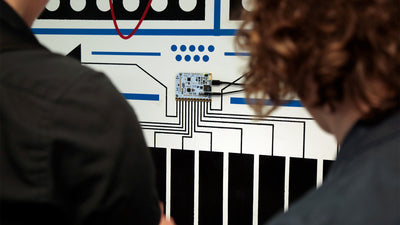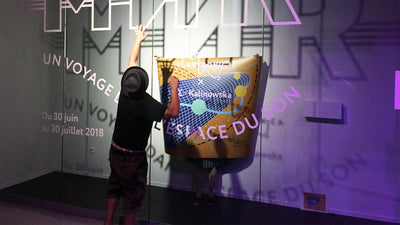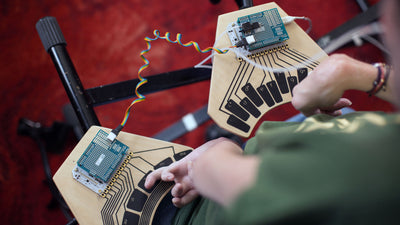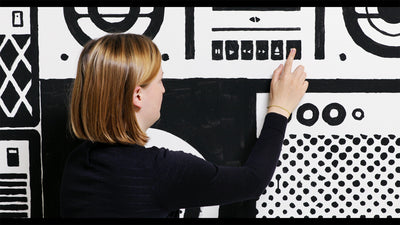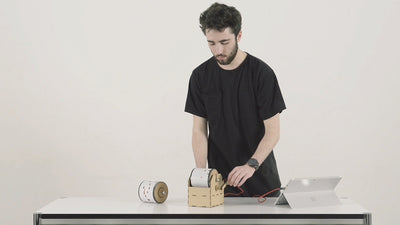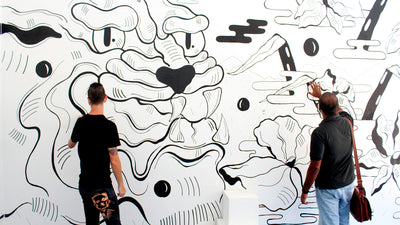Polyphonic Playground - An Interactive Playground For A Design Festival

We've got the super talented team behind Studio PSK and a commission by Fashion to thank for this dynamic , with the Touch Board and Electric Paint. This interactive playground scaled to adult size, is an investigation into multi-sensory play encouraging , pulling in beatboxing from Reeps One and inviting to trigger and distort the soundscape.
We caught up with Patrick Stevenson-Keating, who has already done some beautiful things with Electric Paint, to find out more about this project which is both fun and beautiful in equal measures.
POLYPHONIC PLAYGROUND from Studio PSK on Vimeo.
Bare Conductive loves the Polyphonic Playground, we just wish we’d got a chance to have a go ourselves! Was ‘play’ a central theme when designing the interaction?
The good news is that you will be able to now, as part of London ! We were always very clear from the start that we wanted 'play' to be an important part of the . It seemed to make sense to us - it was a feature that unified both our approach, and that of Reeps One. I think one of the core characteristics of PSK is using play, with and lightheartedness as a way to engage and with people. Often we communicate quite complex ideas or narratives, but by employing a playful strategy to do so, we can engage with the to a more meaningful . This was certainly the hope for the Polyphonic Playground.
You worked with beatboxer Reeps One. How were his beats triggered, and was there a mix of pre-recorded and live sound?
We really loved working with Reeps! His approach to the project really matched our own, and it made the whole process a lot of fun. Reeps recorded a number of different banks of samples which were loaded onto Ableton Live. Each of these were then mapped onto a trigger on the playground. For the triggers, we used Electric Paint, screen printed onto paper tiles, covered by protective acrylic. As clambered over the or slid down the slide, they would touch the triggers, and set off the sounds. Reeps One also did a number of live performances with these pre-recorded sounds creating unique tracks harmonising with himself.
You managed to screen print some really beautiful graphics with Electric Paint. Why did you choose these designs, and did you encounter any obstacles when making such large sensors?
The of the sensors was a result of both aesthetic and functional constraints with the . After a number of consultations with Matt at Bare Conductive, and experimenting with the paint, we realised that a matrix style pattern would give much better sensitivity at this size rather than a more solid . This provided an opportunity to really explore the of the sensors too. We took inspiration from both musical score sheets, and circuit boards to arrive at the patterns of the sensors.
That's pretty cool. Was there a difference in performance between the various sensor substrates - i.e. the climbing frame and the swing?
The main sensor constructions used were Electric Paint onto paper substrate, but for the objects we also used copper tape in the slide, and conductive thread woven into the swings. Each have their pros and cons. The Electric Paint sensors were great as they were very easy to produce in number, and had great repeatability and uniformity in how they responded. Once we set all the individual levels correctly, they worked really well. The copper tape also worked really well. We needed something a bit less resistive for the slide as is was to such a . The conductive thread was quite an experiment. I don't think anyone had ever woven such a large and complex sensor, but again it worked well. The main inhibiting factor was the length of cables used to connect the sensors to the Touch Board. But we overcame this by careful planning of their locations.
How did you get on with the Touch Board? Do you have any advice for others out there taking on interactive installation projects?
The Touch Board really made this project possible, without it, it would have been a much bigger technical challenge. The project was always ambitious from the start - I don't think anyone had done a project using Electric Paint and Touch Boards at this scale before, so it was a bit of a step into the unknown. However the simplicity of working with the , made connecting such a large number of sensors easy. We did a first iteration of this project during Miami last year, and completely re-wrote the software for Milan. We used Max MSP as an intermediary between the Touch Board and Ableton, and this was a massive improvement. It let us tweak the response levels at a very fine resolution, and easily filter out noise. This made the system a lot more reliable than the first version.
Miami, Milan, London …What’s next for the playground?


